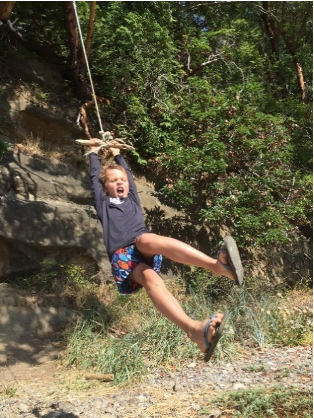Children Need Risky Play to Thrive


Photo by Mariana Brussoni
Are you a parent trying to help your child navigate the complexity of a world that seems designed to undermine their faith and character? If so, I recommend the blog called AfterBabel. For example, check out excerpts from an essay on the importance of risky play by Marianna Brussoni.
We parents desperately want to keep our children safe and ensure their success. We are also often terrified that they will get hurt and that they will fail—so we do everything we can to prevent that from happening. Yet many of those very efforts to manage our fears have paradoxically reduced our children’s safety.
When we prioritize children’s play, we help create environments where children and youth thrive. When we don’t, the consequences can be dire.
Every successive generation of children since the 1970s has seen their outdoor play and freedom shrink. In the U.S., only 16% of children in 1997 played outdoors every day. By 2003—just six years later—that dropped even further to 10%.
What Is Risky Play and Why Does It Matter?
When children have the time, space, and freedom to play the way they choose, it’s not long before they start taking risks in their play, such as climbing higher than they usually do, building secret dens, or racing on their bikes. This is no accident. Children are wired for risky play, in which they take physical risks, seek excitement, and satisfy curiosity.
Examples of risky play: climbing, sledding, using hammers, knives, rough-and-tumble play, playing in their neighborhood with no adult supervision. This kind of play involves children pushing themselves beyond their previous limits and not knowing how things will turn out. As a result, they simultaneously experience thrill and fright. All children need risky play.
Risky play provides children with low-cost opportunities to develop the physical and cognitive skills to master the challenges that they will face as they grow older. Cognitively, it helps them overcome their fears, build their critical thinking skills, and become accustomed to coping independently with difficult situations.
Risky play can help children overcome anxiety disorders and the cognitive distortions that go along with them. Anxious children have difficulty tolerating uncertainty. Through risky play, children practice dealing with strong ambiguous emotions. It can also show them that they are resilient and capable of coping when things go wrong. Research shows that children with more opportunities for risky play have lower internalizing symptoms that are characteristic of anxiety disorders.
Why is risky play disappearing from children’s lives?
Parents, particularly mothers, have been encouraged to micro-manage their children’s lives, curate their experiences, remove any barriers, and enroll them in diverse structured activities with the intention of enhancing their development and giving them an edge in the race to succeed. This approach to parenting has become like the air we breathe—widely accepted in North America—with parents of all backgrounds held to its unrealistic standard regardless of whether they can afford the necessary time, money, and energy.
This costly parenting strategy has negligible benefits at best, and can even be harmful. Research shows that enrollment in structured activities is not associated with improved developmental outcomes, and the loss of free time can be detrimental to developing basic executive function skills. When positive effects of intensive parenting have been shown, they’ve been modest and insufficient to offset the substantial costs to parents.
Parents today receive constant messaging that in order to be “good parents”, they must always keep their children safe. And it is widely believed that the world is no longer a safe place for children to play in. Yet statistics show that it has never been a safer time to be a child. Injury-related deaths are at an all-time low in most Western nations. In the US, deaths from unintentional injuries fell by 73% for boys and 85% for girls between 1973 and 2010. This misperception of risk creates the parental paradox.
The very strategies that parents use to try to keep their children safe – driving them around, maximizing supervision, and minimizing freedom – are unintentionally increasing the likelihood of injuries and even death.
Three ingredients to bring back risky play and childhood freedom
The three key ingredients necessary for thriving play environments are Time, Space, and Freedom.
Time: Make daily outdoor playtime a priority.
Space: Children need easy access to stimulating spaces for play; flexible spaces where they can use their imagination and explore risks, rather than spaces dominated by rules.
Freedom: Children need freedom to be able to play the way they choose. The biggest barrier to children’s freedom is us – the adults in their lives – and our need to manage our own fears. Our lab developed the OutsidePlay.org parent tool to help them work through their challenges, figure out what works best for them and develop a plan for change. We’ve tested it rigorously and it works.




Hello,
My name is Tony, and I loved and agree 100% with this.
I’m a Father of two adult boys and a Grandfather to 5 beautiful grandchildren. Watching my children grow up The Greatest!! However as any parent, yes I worried and feared for their safety in my fears in life. I knew I couldn’t stop them from wanting to live their life and dreams, regardless of the fear of something happening to them. Giving them the room allowed them to test and be tested without mommy and daddy watching over their every move. Yes they got hurt long with their feeling, but they lived and gained so much more by doing for themselves and taking risks. Now I watch my Grandchildren play with risk, and it still scares me at times but it is risk that we take that shape us for the future. I’m Grateful to the Lord that he watches over them and all the children of this world, and reading articles and see others understanding’s of how important this is. My hope is to let kids be kids and parents having more faith in knowing the Lord, trusting in him with the safety in which they came from and created by. All of us have a purpose in life even Children.
Thank you
Tony
It’s wonderful to be a grandfather and to be able to encourage children. In general, moms and grandmoms are built to give unconditional love. Dads and granddads do better at seeing the untapped potential in a kid that will only reveal itself when they are challenged at a new level. Without the love, you get insecurity. Without the challenge, you get a coddled teenager who keeps looking to mom for help when his or her peers have long since mastered the requirements of that stage.
Agreed. We as adults, also try to keep everything in our lives comfortable and pass that comfort seeking on to our kids.
Kids can be so resilient if given the opportunity and space to try. For example, I have three little girls, ages 5 through 7. This weekend, they joined me in a cold plunge challenge. My girls will complain about cold water when washing their hands. I wanted to show them that cold water isn’t something to be afraid of but can be fun. We did the cold plunge in our bathtub with cold water, it was 54 degrees. We did a series of challenges. First was putting their feet in. Then sitting for 1 second. Then 10 seconds, and eventually they were dunking their heads under and stayed in and started to play with their water toys. They felt so proud afterward.
You are a great dad, Neil. Your girls are lucky to have you!
I have to give my wife full credit for encouraging this with our kids as much as she has. She’s all about prioritizing they get time outside. Besides the laundry part, she loves it when the kids come back with dirt on themselves. We’re currently doing a 1,000 Hour Challenge of the kids playing outside for 1k hours this year. It’s good for them and–maybe more importantly–gets us outside and active with them too.
Yeah, Weston, you married a good one. She does a fantastic job.